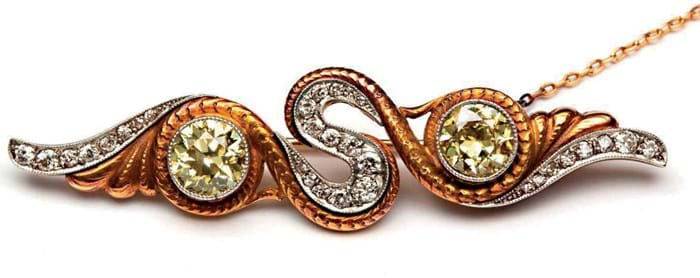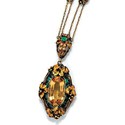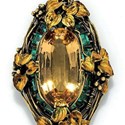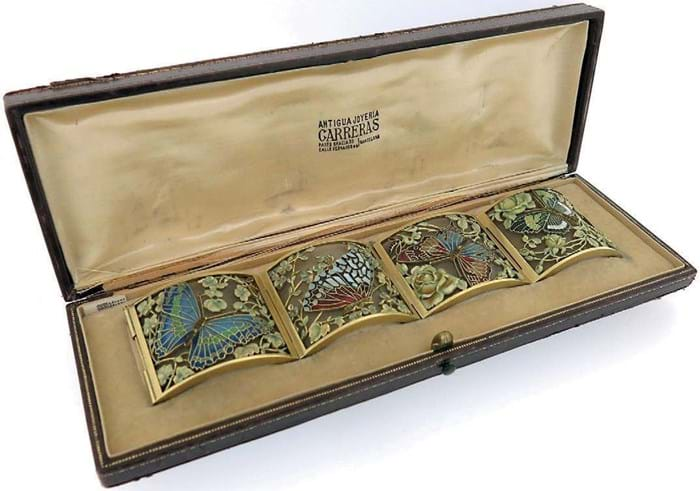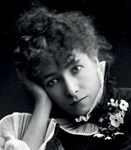
In different European countries the new international style that evolved around the turn of the 20th century was known by different names: Art Nouveau in France, Jugendstil in Germany, Stile Liberty in Italy and Modernisme in Spain. This new style was also interpreted in different ways.
Jewels designed by Wiener Werkstätte founder Josef Hoffmann (1870-1956) and executed by goldsmith Eugen Pflaumer, represent the quintessence of the geometric style that characterised the Austrian ‘Secessionist’ approach to design.
In June 2015 two brooches by Hoffmann, which had been owned by the same German family since c.1908, caused a sensation when they were offered for sale at Vienna auction house Kinsky.
One, assuming a form akin to the façade of the Palais Stoclet – the large house in Brussels considered Hoffmann’s architectural masterpiece – sold to a New York institution at €280,000 (£205,880).
It held an auction record for about five minutes before the following lot, a brooch completed in 1908 resembling the Vienna exhibition hall, sold to a Berlin museum at €420,000 (£308,825).
Pflaumer was employed as a goldsmith at the Wiener Werkstätte from 1903-06 and continued to produce selected pieces of jewellery for the workshops after turning to teaching in 1907. At the time brooches such as this were priced at around 400 Austro-Hungarian krone – a significant outlay.
A brooch offered by Kinsky (26% buyer’s premium) last week on June 24 was fashioned in parcel gilt, lapis lazuli and green cabochons and dated to 1912. In the archives there is no design by Josef Hoffmann for this piece that also lacks an official Wiener Werkstätte mark, suggesting this brooch was not intended for sale and was instead made by Pflaumer for a family member or close friend. Estimated at €25,000-50,000, it sold for €35,000 (£31,350).
Nieuwe Kunst brooch
A sale at De Zwann (29.5% buyer’s premium) in Amsterdam on June 9 included a gold and diamond brooch by Frans Zwollo Sr (1872- 1945), a founding member of the Nederlandsche Vereeniging for Craft and Industrial Art (VANK) and a key figure in Dutch Art Nouveau or the Nieuwe Kunst.
Zwollo trained alongside his father at the Amsterdam silversmith Bonebakker & Zoon but later moved his workshop to The Hague where he was a teacher at the Koninklijke Academie van Beeldende Kunsten.
The brooch, with its distinctive S-shape and two ‘fancy’ light yellow old-cut diamonds of 2.10 and 1.65 carats, came from the family of Willy Schüler who commissioned it as a gift to his wife Selma Wittgenstein. The couple ran a couture shop Maison Schüler et Cie in The Hague from 1884 and would have mixed in the same artistic circles as Zwollo.
A similar brooch dated c.1910-1915 is in the permanent collection of the Rijksmuseum. This one, estimated at €12,000-14,000, sold at €18,000 (£16,070).
Unconventional stones
Although, much like René Lalique in France, Louis Comfort Tiffany’s (1848-1933) successful career as a glassmaker overshadowed his genius as a goldsmith, he created jewels that have come to define Art Nouveau in North America.
Tiffany is among those credited with weaning Gilded Age America off diamonds and pearls.
His head of gemmology George Frederick Kunz supplied the raw materials and fuelled a fascination for colourful and unconventional stones from much closer to home.
Translucent moonstones and emeralds came from North Carolina, tourmalines from the state of Maine and home-grown sapphires from the Yogo Gulch mine in Montana.
Production of Tiffany’s jewels began in 1902 with plans kept largely under wraps until 27 pieces ‘in the hand-wrought style’ were shown at the Louisiana Purchase Exposition, also known as the St Louis World’s Fair, in 1904.
About 5500 pieces of jewellery were produced across Tiffany’s lifetime (he continued to work with a team of designers right up until his death), displaying a broad range of influences from naturalism to the exoticism of North Africa and the Near East.
Hindman’s (25% buyer’s premium) Fine and Important Jewelry Auction in Chicago on May 14 boasted an impressive example of Tiffany ‘Art Jewelry’ – a topaz, emerald and polychrome basse-taille enamel necklace and pendant. It came from the estate of Roseville, Minnesota educator Linda Zoe Jenkins.
Combining the historicism of the Renaissance revival with the sculptural gold leaves of the Art Nouveau, it dates from c.1910, when Tiffany was working closely with designer Julia Munson (1875-1971).
Competition among 17 bidders and four online bidding platforms contributed to the final result of $48,000 (£36,900), well over a pre-sale estimate of $10,000-15,000.
Catalan Spain’s own version of Art Nouveau was known as Modernisme.
The Carreras workshop, founded by Francesco d’Assis Carreras Duran (1797-1862) in Barcelona, is best known as the maker of traditionally styled jewels catering to clients from across the Iberian Peninsula but at the start of the 20th century, influenced by the House of Masriera, it began to follow the new aesthetic impulses.
A splendid Art Nouveau gold and plique-à-jour and cloisonné polychrome enamel bracelet by Carreras c.1905 comes for up sale at Woolley & Wallis in Salisbury in July 15.
It is designed as a series of four slightly curved open yellow gold panels, each with a different butterfly motif among foliage on a frosted glass ground. Signed with an applied gold plaque to reverse ‘E de A. Carreras Barcelona’, it comes in a labelled case. Estimate £50,000-70,000.


